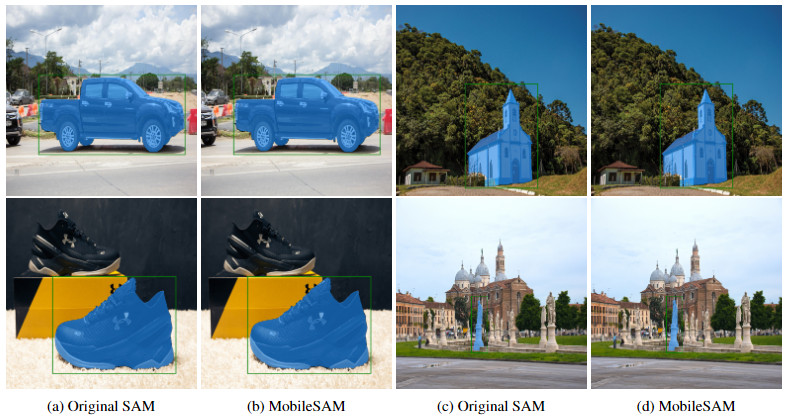description: Discover MobileSAM, a lightweight and fast image segmentation model for mobile applications. Compare its performance with the original SAM and explore its various modes.
keywords: MobileSAM, image segmentation, lightweight model, fast segmentation, mobile applications, SAM, ViT encoder, Tiny-ViT, Ultralytics
A demonstration of MobileSAM running on a CPU can be accessed at this [demo link](https://huggingface.co/spaces/dhkim2810/MobileSAM). The performance on a Mac i5 CPU takes approximately 3 seconds. On the Hugging Face demo, the interface and lower-performance CPUs contribute to a slower response, but it continues to function effectively.
MobileSAM is implemented in various projects including [Grounding-SAM](https://github.com/IDEA-Research/Grounded-Segment-Anything), [AnyLabeling](https://github.com/vietanhdev/anylabeling), and [Segment Anything in 3D](https://github.com/Jumpat/SegmentAnythingin3D).
MobileSAM is trained on a single GPU with a 100k dataset (1% of the original images) in less than a day. The code for this training will be made available in the future.
## Available Models, Supported Tasks, and Operating Modes
This table presents the available models with their specific pre-trained weights, the tasks they support, and their compatibility with different operating modes like [Inference](../modes/predict.md), [Validation](../modes/val.md), [Training](../modes/train.md), and [Export](../modes/export.md), indicated by ✅ emojis for supported modes and ❌ emojis for unsupported modes.
Since MobileSAM retains the same pipeline as the original SAM, we have incorporated the original's pre-processing, post-processing, and all other interfaces. Consequently, those currently using the original SAM can transition to MobileSAM with minimal effort.
MobileSAM performs comparably to the original SAM and retains the same pipeline except for a change in the image encoder. Specifically, we replace the original heavyweight ViT-H encoder (632M) with a smaller Tiny-ViT (5M). On a single GPU, MobileSAM operates at about 12ms per image: 8ms on the image encoder and 4ms on the mask decoder.
The following table provides a comparison of ViT-based image encoders:
The performance of MobileSAM and the original SAM are demonstrated using both a point and a box as prompts.


With its superior performance, MobileSAM is approximately 5 times smaller and 7 times faster than the current FastSAM. More details are available at the [MobileSAM project page](https://github.com/ChaoningZhang/MobileSAM).
## Testing MobileSAM in Ultralytics
Just like the original SAM, we offer a straightforward testing method in Ultralytics, including modes for both Point and Box prompts.
### Model Download
You can download the model [here](https://github.com/ChaoningZhang/MobileSAM/blob/master/weights/mobile_sam.pt).
MobileSAM is a lightweight, fast image segmentation model designed for mobile applications. It retains the same pipeline as the original SAM but replaces the heavyweight ViT-H encoder (632M parameters) with a smaller Tiny-ViT encoder (5M parameters). This change results in MobileSAM being approximately 5 times smaller and 7 times faster than the original SAM. For instance, MobileSAM operates at about 12ms per image, compared to the original SAM's 456ms. You can learn more about the MobileSAM implementation in various projects [here](https://github.com/ChaoningZhang/MobileSAM).
### How can I test MobileSAM using Ultralytics?
Testing MobileSAM in Ultralytics can be accomplished through straightforward methods. You can use Point and Box prompts to predict segments. Here's an example using a Point prompt:
MobileSAM is ideal for mobile applications due to its lightweight architecture and fast inference speed. Compared to the original SAM, MobileSAM is approximately 5 times smaller and 7 times faster, making it suitable for environments where computational resources are limited. This efficiency ensures that mobile devices can perform real-time image segmentation without significant latency. Additionally, MobileSAM's models, such as [Inference](../modes/predict.md), are optimized for mobile performance.
MobileSAM was trained on a single GPU with a 100k dataset, which is 1% of the original images, in less than a day. While the training code will be made available in the future, you can currently explore other aspects of MobileSAM in the [MobileSAM GitHub repository](https://github.com/ultralytics/assets/releases/download/v8.2.0/mobile_sam.pt). This repository includes pre-trained weights and implementation details for various applications.